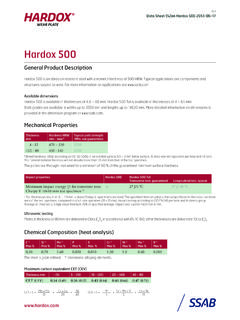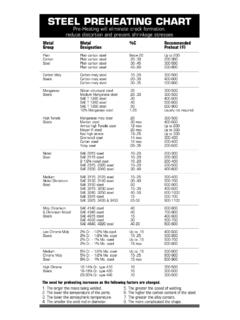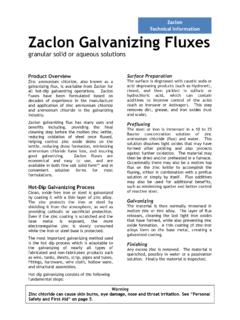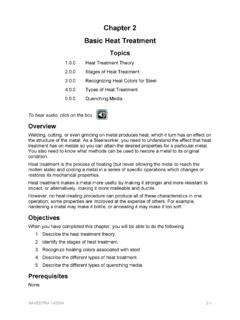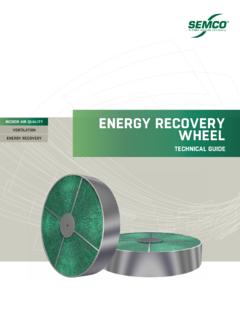Transcription of Welding Hardox and Weldox - A&E Mach
1 Welding Hardox and Weldox . The contents of this brochure represent general suggestions. SSAB AB accepts no responsibility for their suitability in individual cases. The user is therefore responsible to make the necessary adaptations to the conditions in each individual case. Welding of Weldox and Hardox . The extreme performance of Weldox high strength steel and Hardox wear plate is combined with exceptional weldability. Any conventional Welding method can be used for Welding these steels to any type of weldable steel . This brochure is aimed at simplifying, improving and boosting the efficiency of the Welding process. It offers good advice on preheat and interpass temperatures, heat input, Welding consumables, shielding gas and a great deal more. The aim is to enable every user to gain full benefit of the unique properties of Weldox and Hardox .
2 Important parameters in Welding Clean the joint to remove foreign matter such as moisture and oil residue before Welding . In addition to good Welding hygiene, the following items are important: Preheat and interpass temperature Shielding gas Heat input Weld sequence and gap size in the joint Welding consumables Preheat and interpass temperatures The right preheat and interpass temperature is important in order to avoid hydrogen cracking. Our recommendations are given in the table on the next page. Influence of alloying elements on the choice of preheat and interpass temperatures A unique combination of alloying elements optimizes The alloying elements are specified in the inspection cer- the mechanical properties of Weldox and Hardox . This tificate of the plate and are stated in percent by weight combination governs the preheat and interpass tem- in these formulas.
3 A higher carbon equivalent usually perature of the steel during Welding , and can be used requires a higher preheat and interpass temperature. to calculate the carbon equivalent value. The carbon Typical values of carbon equivalents are given in our equivalent value is usually expressed as CEV or CET in product data sheets. accordance with the equations below. Mn (Mo+Cr+V) (Ni+Cu) (Mn+Mo) (Cr+Cu) Ni CEV = C + + + [%] CET = C + + + [%]. 6 5 15 10 20 40. Hydrogen cracking Due to their low carbon equivalents, Weldox and Hardox are better able to resist hydrogen cracking than many other high strength steels. The risk of hydrogen cracking will be minimized if our recommendations are followed. Two rules for avoiding hydrogen cracking: 1. Minimize the hydrogen content in and around 2. Minimize the stresses in the weld joint the prepared joint Use the right preheat and interpass Do not use Welding consumables of a higher temperature strength than is necessary Use Welding consumables with a low Arrange the weld sequence so that the hydrogen content residual stresses are minimized Keep impurities out of the weld area Set the gap in the joint to a maximum of 3 mm Preheat and interpass temperatures for Weldox and Hardox The lowest preheat and interpass temperature during Welding is shown in the chart below.
4 Unless otherwise stated, these values are applicable for Welding with unalloyed and low-alloyed Welding consumables. When plates of different thicknesses, but of the same steel grade are welded together, the thickest plate determines the required preheat and interpass temperature. When different steel types are welded together, the plate requiring the highest preheat temperature determines the required preheat and interpass temperature. MINIMUM RECOMMENDED PREHEAT AND INTERPASS TEMPERATURES FOR DIFFERENT SINGLE PLATE THICKNESSES [mm]. 3 10 20 30 40 50 60 70 80 90 120 130. Weldox 700 75 C 100 C. Weldox 900* 75 C 100 C. Weldox 960* 100 C. 75 C. Weldox 1030*. Weldox 1100* 125 C. Weldox 1300* 100 C. Hardox HiTuf 100 C 125 C. Hardox 400 75 C 100 C 175 C 200 C. Hardox 450 125 C 150 C. Hardox 500 175 C 200 C.
5 Hardox 550 125 C 175 C 200 C. Hardox 600 150 C 175 C. Hardox 600 100 C. Stainless steel consumables Hardox Extreme 100 C. Stainless steel consumables Room temperature (approx. 20 C) Outside the size range Only stainless steel consumables Note: The table is applicable to single plate thickness when Welding with a heat input of kJ / mm. Further information on single plate thickness can be found in TechSupport #61 at t1 = t 2 (dimensions in mm). Maximum recommended interpass temperature The single plate thickness in the table is t1 or t 2, provided that the Weldox 700** 300 C same steel type is used. Weldox 900** 300 C. Weldox 960** 300 C. t 1= t 2 (dimensions in mm). Weldox 1030 200 C. The single plate thickness in the table is t1 or t 2, provided that the Weldox 1100 200 C. same steel type is used. Weldox 1300 200 C.
6 Hardox HiTuf** 300 C. Hardox 400 225 C. Hardox 450 225 C. Hardox 500 225 C t1 < t 2 (dimensions in mm). In this case, the single plate thick- Hardox 550 225 C ness in the table is t 2, provided that the same steel type Hardox 600 225 C is used. Hardox Extreme 100 C. * The consumables determine the preheating temperature if its carbon equivalent is higher than that of the plate. ** Interpass temperatures of up to approx. 400 C can be used in certain cases for Weldox 700 960 and for Hardox HiTuf. In such cases, use WeldCalc. If the ambient humidity is high or the temperature is affected at heat inputs higher than kJ / mm. below +5 C, the lowest recommended preheat tempera- The information is based on the assumption that the tures given on the previous page should be increased by welded joint is allowed to cool in air.
7 25 C. This also applies to firmly clamped weld joints Note that these recommendations also apply to tack and if the heat input is kJ / mm. welds and root runs. Each of the tack welds should be at The lowest recommended preheat and interpass least 50 mm long. The distance between tack welds can temperatures in the chart on the previous page are not be varied as required. Attaining and measuring the preheat and interpass temperature The required preheat and interpass temperature can be provide uniform heating of the area. The temperature achieved in several ways. Electric preheater elements should be monitored by using, for example, a contact around the prepared joint are often best, since they thermometer. Measure the preheat temperature here 75 mm Intended weld joint Measure the temperature of the thickest plate in the joint.
8 If the plate is 25 mm thick, measure the temperature 2 minutes after heating. If the plate is mm thick, measure the temperature after 1 minute, etc. The interpass temperature can be measured in the weld metal or in the immediately adjacent parent metal. Using preheater elements Heat input Welding with the recommended heat input results in good mechanical properties in the heat affected zone (HAZ). The heat supplied by the Welding process affects the Different methods of Welding have varying thermal mechanical properties of the welded joint. This is efficiency (k). See the table below for approximate described by the heat input (Q) that can be calculated values of this property. using the formula below. Q = k U x x I x 60. Thermal efficiency k [dimensionless]. v x 1000. Q = Heat input [kJ/mm] MMA U = Voltage [V] MAG, all types I = Current [A] SAW v = Welding speed [mm/min] TIG k = Thermal efficiency [dimensionless].
9 Effects of heat input on a weld joint Better toughness Higher productivity for Increased strength Reduced heat input Increased heat input conventional Welding methods Reduced deformation Lower residual stresses Narrower HAZ. Our recommendations for Weldox high strength steel are based on typical values for toughness in the HAZ being at least 27 J at -40 C. The demands on toughness in the weld joints in Hardox wear plate are often lower. The recommendations for Hardox should therefore be regarded as approximate values. 11 mm When a joint comprising different plate thicknesses is welded, the recommended heat input is based on the thinnest plate in the welded joint. 20 mm In this case, the permissible heat input is based on the 11 mm plate thickness. RECOMMENDED MAXIMUM HEAT INPUT FOR Weldox , BASED ON THE LOWEST PREHEAT TEMPERATURE BEING USED: 4,0.
10 Qmax Weldox 700. 3,5 Qmax Weldox 900. Qmax Weldox 960. 3,0. Qmax Weldox 1030. Qmax Weldox 1100. 2,5. Heat input [kJ/mm]. Qmax Weldox 1300. 2,0. 1,5. 1,0. 0,5. 0,0. 0 5 10 15 20 25 30 35 40 130. Plate thickness [mm]. RECOMMENDED MAXIMUM HEAT INPUT FOR Hardox . Hardox Heat input [kJ/mm]. 0 5 10 15 20 25 30 35 40-130. Plate thickness [mm]. Welding at higher elevated temperatures Higher elevated temperatures that may occur, for instance in multipass weld joints, affect the recommended heat input. The figure below shows the recommended heat inputs for joint temperatures of 125 C and 175 C. RECOMMENDED MAXIMUM HEAT INPUT FOR THE JOINT TEMPERATURE OF 125 C. 4,0. Qmax Weldox 700. 3,5. Qmax Weldox 900. Qmax Weldox 960 1300. 3,0. 2,5. Heat input [kJ/mm]. 2,0. 1,5. 1,0. 0,5. 0,0. 0 5 10 15 20 25 30 35 40 130. Plate thickness [mm].
